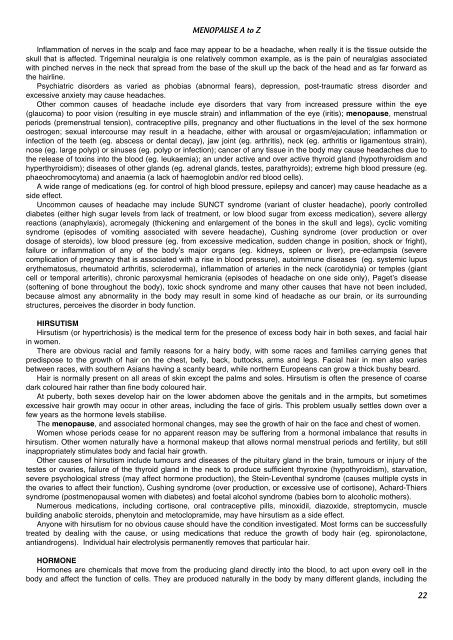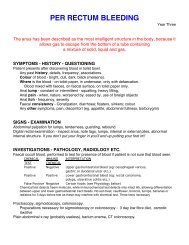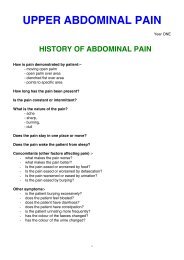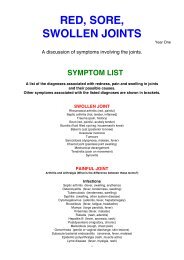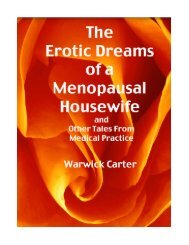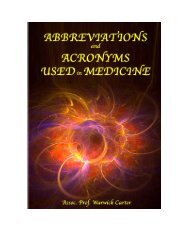Menopause A to Z.pdf - Medwords.com.au
Menopause A to Z.pdf - Medwords.com.au
Menopause A to Z.pdf - Medwords.com.au
Create successful ePaper yourself
Turn your PDF publications into a flip-book with our unique Google optimized e-Paper software.
MENOPAUSE A <strong>to</strong> Z<br />
Inflammation of nerves in the scalp and face may appear <strong>to</strong> be a headache, when really it is the tissue outside the<br />
skull that is affected. Trigeminal neuralgia is one relatively <strong>com</strong>mon example, as is the pain of neuralgias associated<br />
with pinched nerves in the neck that spread from the base of the skull up the back of the head and as far forward as<br />
the hairline.<br />
Psychiatric disorders as varied as phobias (abnormal fears), depression, post-tr<strong>au</strong>matic stress disorder and<br />
excessive anxiety may c<strong>au</strong>se headaches.<br />
Other <strong>com</strong>mon c<strong>au</strong>ses of headache include eye disorders that vary from increased pressure within the eye<br />
(gl<strong>au</strong><strong>com</strong>a) <strong>to</strong> poor vision (resulting in eye muscle strain) and inflammation of the eye (iritis); menop<strong>au</strong>se, menstrual<br />
periods (premenstrual tension), contraceptive pills, pregnancy and other fluctuations in the level of the sex hormone<br />
oestrogen; sexual intercourse may result in a headache, either with arousal or orgasm/ejaculation; inflammation or<br />
infection of the teeth (eg. abscess or dental decay), jaw joint (eg. arthritis), neck (eg. arthritis or ligamen<strong>to</strong>us strain),<br />
nose (eg. large polyp) or sinuses (eg. polyp or infection); cancer of any tissue in the body may c<strong>au</strong>se headaches due <strong>to</strong><br />
the release of <strong>to</strong>xins in<strong>to</strong> the blood (eg. leukaemia); an under active and over active thyroid gland (hypothyroidism and<br />
hyperthyroidism); diseases of other glands (eg. adrenal glands, testes, parathyroids); extreme high blood pressure (eg.<br />
phaeochromocy<strong>to</strong>ma) and anaemia (a lack of haemoglobin and/or red blood cells).<br />
A wide range of medications (eg. for control of high blood pressure, epilepsy and cancer) may c<strong>au</strong>se headache as a<br />
side effect.<br />
Un<strong>com</strong>mon c<strong>au</strong>ses of headache may include SUNCT syndrome (variant of cluster headache), poorly controlled<br />
diabetes (either high sugar levels from lack of treatment, or low blood sugar from excess medication), severe allergy<br />
reactions (anaphylaxis), acromegaly (thickening and enlargement of the bones in the skull and legs), cyclic vomiting<br />
syndrome (episodes of vomiting associated with severe headache), Cushing syndrome (over production or over<br />
dosage of steroids), low blood pressure (eg. from excessive medication, sudden change in position, shock or fright),<br />
failure or inflammation of any of the body’s major organs (eg. kidneys, spleen or liver), pre-eclampsia (severe<br />
<strong>com</strong>plication of pregnancy that is associated with a rise in blood pressure), <strong>au</strong><strong>to</strong>immune diseases (eg. systemic lupus<br />
erythema<strong>to</strong>sus, rheuma<strong>to</strong>id arthritis, scleroderma), inflammation of arteries in the neck (carotidynia) or temples (giant<br />
cell or temporal arteritis), chronic paroxysmal hemicrania (episodes of headache on one side only), Paget’s disease<br />
(softening of bone throughout the body), <strong>to</strong>xic shock syndrome and many other c<strong>au</strong>ses that have not been included,<br />
bec<strong>au</strong>se almost any abnormality in the body may result in some kind of headache as our brain, or its surrounding<br />
structures, perceives the disorder in body function.<br />
HIRSUTISM<br />
Hirsutism (or hypertrichosis) is the medical term for the presence of excess body hair in both sexes, and facial hair<br />
in women.<br />
There are obvious racial and family reasons for a hairy body, with some races and families carrying genes that<br />
predispose <strong>to</strong> the growth of hair on the chest, belly, back, but<strong>to</strong>cks, arms and legs. Facial hair in men also varies<br />
between races, with southern Asians having a scanty beard, while northern Europeans can grow a thick bushy beard.<br />
Hair is normally present on all areas of skin except the palms and soles. Hirsutism is often the presence of coarse<br />
dark coloured hair rather than fine body coloured hair.<br />
At puberty, both sexes develop hair on the lower abdomen above the genitals and in the armpits, but sometimes<br />
excessive hair growth may occur in other areas, including the face of girls. This problem usually settles down over a<br />
few years as the hormone levels stabilise.<br />
The menop<strong>au</strong>se, and associated hormonal changes, may see the growth of hair on the face and chest of women.<br />
Women whose periods cease for no apparent reason may be suffering from a hormonal imbalance that results in<br />
hirsutism. Other women naturally have a hormonal makeup that allows normal menstrual periods and fertility, but still<br />
inappropriately stimulates body and facial hair growth.<br />
Other c<strong>au</strong>ses of hirsutism include tumours and diseases of the pituitary gland in the brain, tumours or injury of the<br />
testes or ovaries, failure of the thyroid gland in the neck <strong>to</strong> produce sufficient thyroxine (hypothyroidism), starvation,<br />
severe psychological stress (may affect hormone production), the Stein-Leventhal syndrome (c<strong>au</strong>ses multiple cysts in<br />
the ovaries <strong>to</strong> affect their function), Cushing syndrome (over production, or excessive use of cortisone), Achard-Thiers<br />
syndrome (postmenop<strong>au</strong>sal women with diabetes) and foetal alcohol syndrome (babies born <strong>to</strong> alcoholic mothers).<br />
Numerous medications, including cortisone, oral contraceptive pills, minoxidil, diazoxide, strep<strong>to</strong>mycin, muscle<br />
building anabolic steroids, pheny<strong>to</strong>in and me<strong>to</strong>clopramide, may have hirsutism as a side effect.<br />
Anyone with hirsutism for no obvious c<strong>au</strong>se should have the condition investigated. Most forms can be successfully<br />
treated by dealing with the c<strong>au</strong>se, or using medications that reduce the growth of body hair (eg. spironolac<strong>to</strong>ne,<br />
antiandrogens). Individual hair electrolysis permanently removes that particular hair.<br />
HORMONE<br />
Hormones are chemicals that move from the producing gland directly in<strong>to</strong> the blood, <strong>to</strong> act upon every cell in the<br />
body and affect the function of cells. They are produced naturally in the body by many different glands, including the<br />
22


